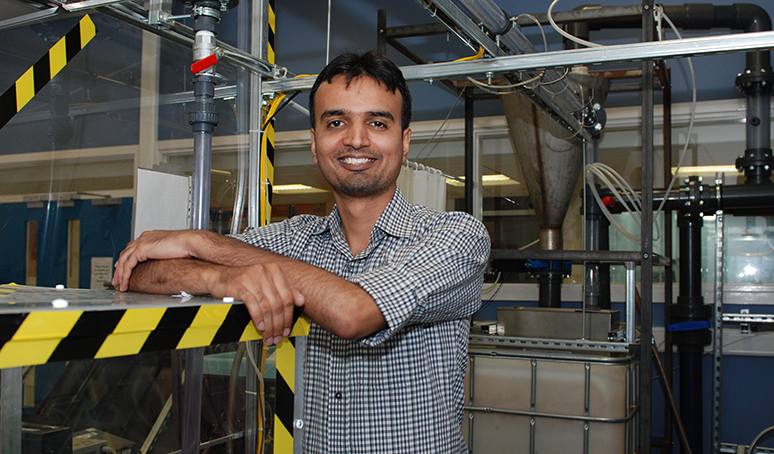New flow diagnostics model for hydraulic capsule pipeline
 Dr Taimoor Asim pictured with a flow loop setup in the Fluid Mechanics Lab
Dr Taimoor Asim pictured with a flow loop setup in the Fluid Mechanics Lab
Mon, 01 Aug 2016 12:18:00 BST
New mathematical prediction models will enable designers to achieve optimal performance at the lowest possible cost
 ► Dr Asim in the Laser Lab where he uses 3D PIV (particle image velocimetry) for analysing capsule flow
► Dr Asim in the Laser Lab where he uses 3D PIV (particle image velocimetry) for analysing capsule flow
PIPELINES that carry capsules containing almost any type of freight over long distances have the potential to become an important, cost-effective and environmentally friendly form of transportation. Now, research by a University of Huddersfield scientist has led to the development of mathematical models that can ensure new pipeline systems are designed to be as economic and efficient as possible.
Dr Taimoor Asim is Research Fellow in Flow Diagnostics at the University’s School of Computing and Engineering and a member of its Energy, Emissions and the Environment Research Group. It was during his postgraduate studies at the University that he first developed his interest in hydraulic capsule pipelines (HCP) and in computational fluid dynamics (CFD), a complex science that uses mathematics, physics and computational software to visualise how a gas or liquid flows.
Now Dr Asim has harnessed CFD as a means of investigating the optimum design for HCPs and his findings are being released in a series of articles.
They stem from his PhD thesis – supervised by the University of Huddersfield’s Professor Rakesh Mishra, a leading authority on CFD – that was titled Computational Fluid Dynamics Based Diagnostics and Optimal Design of Hydraulic Capsule Pipelines.
Although pneumatic pipelines have been in widespread use since the Victorian period – for conveying capsules containing documents in shops and offices for example – hydraulic pipelines, which propel capsules through water, are a more recent development and although they have been used in some industrial locations their full potential is yet to be realised.
A hydraulic capsule pipeline can convey bulk solids very effectively, argues Dr Asim. The pipelines can be economically and environmentally efficient because they incur considerably lower energy costs and reduce the amount of road traffic used to transport freight.
But careful investigation of factors such as the geometric, fluid and flow characteristics within a pipeline is vital and Dr Asim’s CFD-based semi-empirical mathematical prediction models provide designers with a tool that will enable them to achieve optimal performance at the lowest possible cost.
The capsules propelled through hydraulic pipelines (as seen in the video) could be cylindrical, spherical, rectangular or an arbitrary shape derived from all three, says Dr Asim. He has worked on CFD models for the basic shape variants and has now embarked on the publication of papers derived from his PhD thesis that deal with all of them individually, showing how their performance can be predicted.
- Computational Fluid Dynamics Based Optimal Design of Hydraulic Capsule Pipelines Transporting Cylindrical Capsules in the International Journal of Powder Technology
- Optimal design of hydraulic capsule pipelines transporting spherical capsules in Canadian Journal of Chemical Engineering
- Development of a Design Methodology for Hydraulic Pipelines Carrying Rectangular Capsules in the International Journal of Pressure Vessels and Piping
Dr Asim is now working towards an article dealing with capsules of an arbitrary shape and how their behaviour can be predicted in a hydraulic pipeline.







